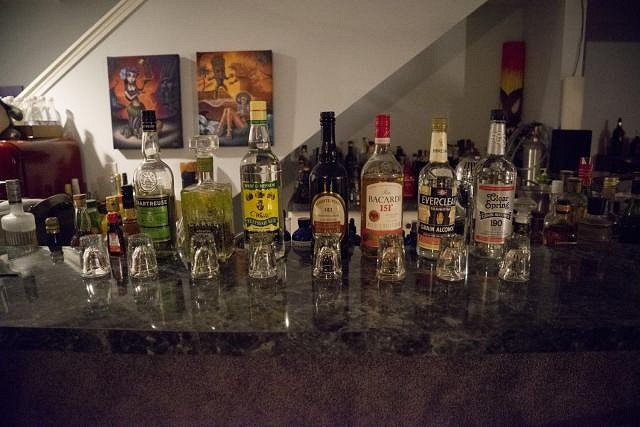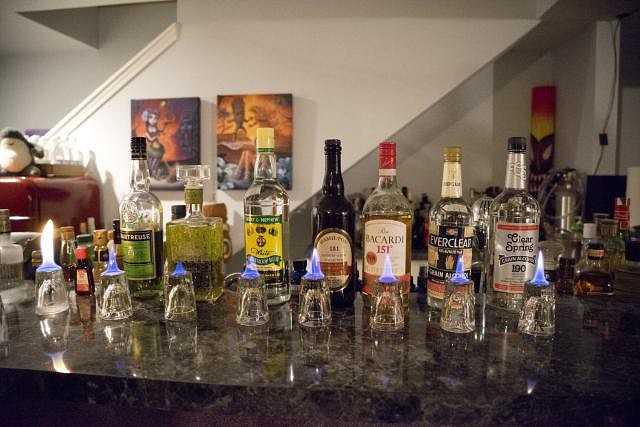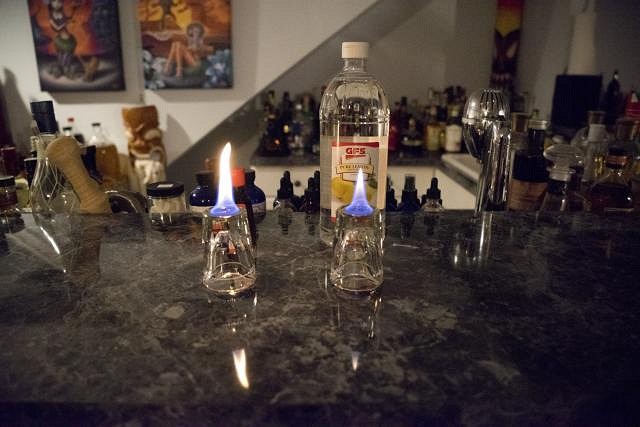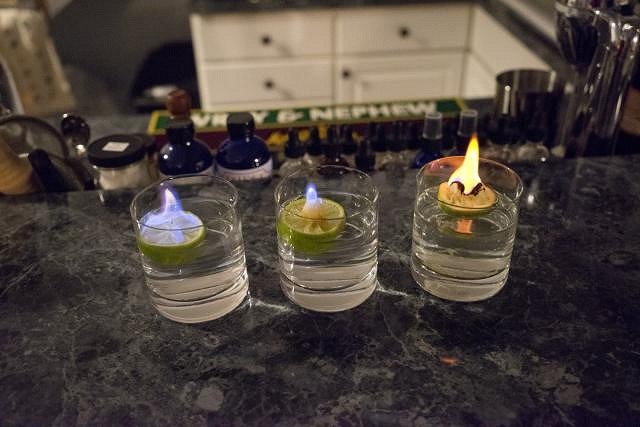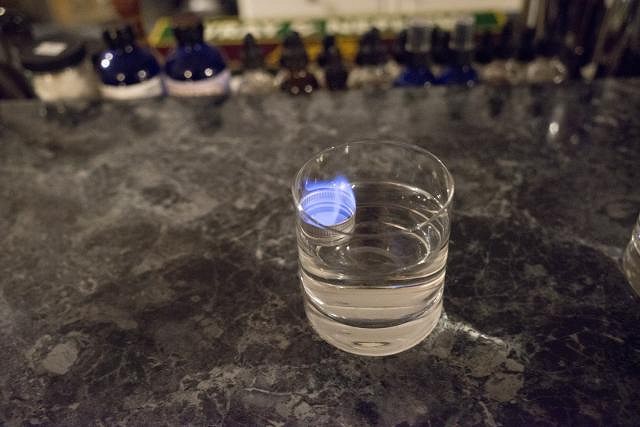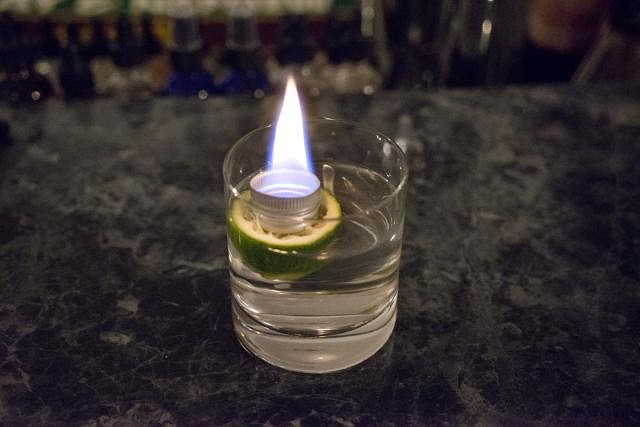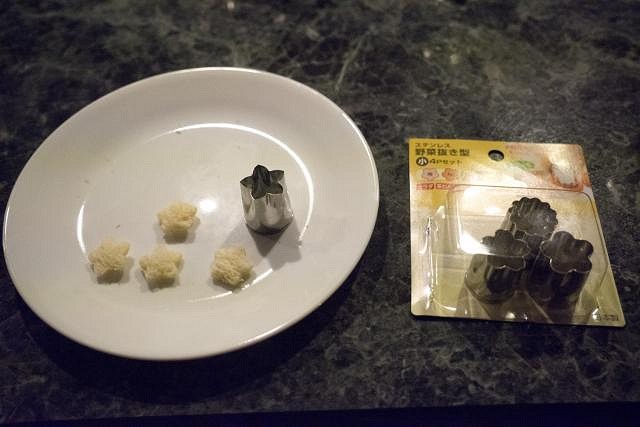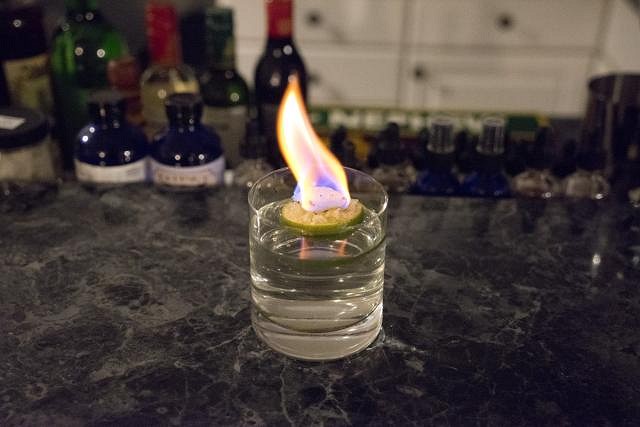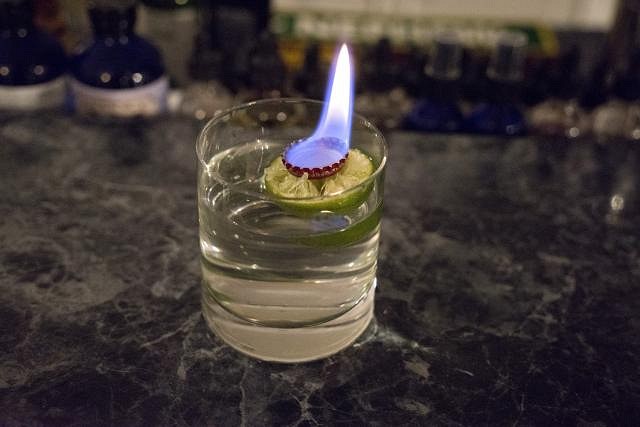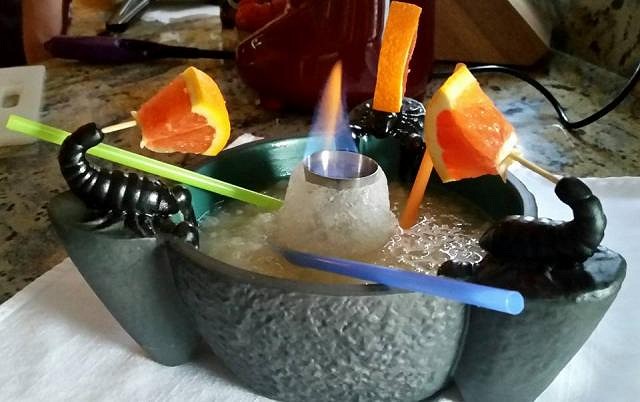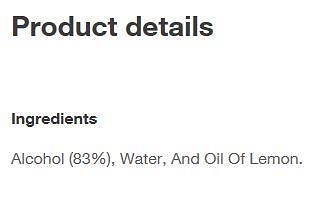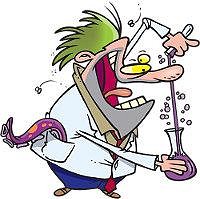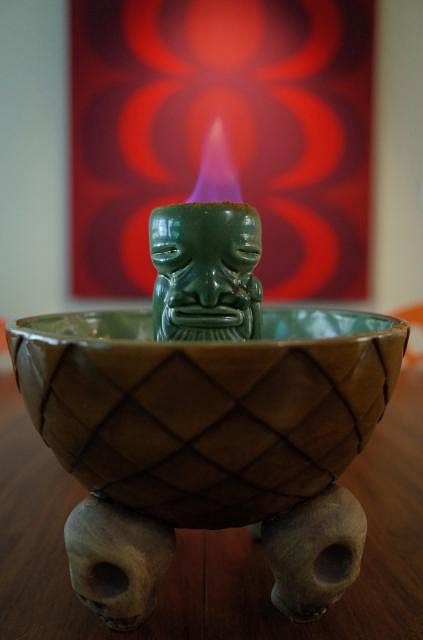Tiki Central / Tiki Drinks and Food
Liquor for Flaming Drinks: A Comparison
Pages: 1 45 replies
|
JB
Jeff Bannow
Posted
posted
on
Sat, Mar 26, 2016 9:23 AM
I couldn't find a comparison of flame quality between alcohols, and I'm always looking for an excuse to light things on fire, so I did a side by side last night. We used shot glasses turned upside down, with about 1/2 oz. of each alcohol. This was shot in subdued light, with all the alcohol at about 60F in temperature.
Here's the cast, from left to right: McCormick Lemon Extract
As expected, anything under 150 proof was pretty unimpressive. The Chartreuse, absinthe, and W&N Overproof were barely visible in room light. In my opinion, there's little point in using these as the flame was too dim. They also left residue in the glass after burning out, potentially affecting the flavor of your drink. The 151s burned very blue, and would be usable in low light. Surprisingly, the Hamilton burned a little brighter than the Bacardi & Everclear, despite the fact that they are all 151 proof. Any of these would be acceptable. The real standouts, though. were the Clear Spring 190, and even more so, the lemon extract. Both were impressive even in room light. The lemon extract was the strongest by far, burning bright and strong.
Here's a second comparison with the lemon extract and the Clear Spring. This was done with fresh shot glasses and fresh pours of alcohol. Here's my final thoughts on the experiment: For drinks where I am floating the alcohol in the drink, I'll use the Clear Spring 190. This way, if some ends up in the drink, it won't significantly affect the taste. Hope this helps someone else out there. Some additional notes I'm adding in to the experiment: Some pricing info for everyone. I found large bottles of lemon extract at my local Gordon Food Services for pretty cheap. Clear Spring 190 proof alcohol: McCormick Lemon Extract: McCormick Lemon Extract: Gordon Food Services store brand lemon extract (not recommended - see note below): Here's a comparison of McCormick's Lemon Extract (left) and Gordon Food Service Lemon Extract (right).
As you can see, the GFS Lemon Extract is no better than the Clear Spring 190. I will be skipping the GFS and continuing to use the McCormick. Found some info online stating that the McCormick is 166 proof (83%). Tested out sprinkling both cinnamon and nutmeg over the flames. Sorry, I tried to get a photo of it but wasn't too successful. The effect was similar to this video - https://www.youtube.com/watch?v=ct9VVOYcbyc The nutmeg was a dud for me - no noticeable sparks. I produce my nutmeg from a whole nut, run over a microplane to generate powder as needed. The nutmeg wasn't as fine as my cinnamon, so that may have some effect on this. The cinnamon made some cool sparks though as expected. I tried shaking the cinnamon onto the fire directly from the shaker, and a lot of the cinnamon ended up on my bar. It would have ruined any drink with excess cinnamon. I had better luck taking off the shaker top and using my fingers to sprinkle a pinch directly over the flame. Ran some more tests tonight. All were filled using GFS lemon extract. While this isn't my favorite for burning (see notes above), I wanted to use some of it up. And, it burns OK enough for the comparison. The limes were on the small side, and all juiced using a handheld citrus squeezer. We had to be careful when squeezing the limes - if you squeeze too hard, the side can split out on the lime shell. If that happens, it won't float properly. Compared the following vessels:
From left to right: We weren't really happy with any of the above options. My wife struck on the idea of using a cap of some kind to hold the alcohol.
Bottle cap with alcohol poured directly inside (worked well, but the cap hugged the side of the glass, making it dangerously hot)
Spent lime shell, with bottle cap with alcohol poured inside (burned bright and long, no smell) Our conclusions: We will be playing with different style caps, maybe even using a beer bottle cap. The only thing to watch would be any kind of plastic insert or liner that some manufacturer's place inside their caps. (The one we used here had a styrofoam piece stuck in the bottom of the cap, that we had to pry out.) I forgot to mention my homemade "crouton" recipe:
Seemed to work very well, and there are so many preservatives in white bread that I would doubt it will ever rot, as long as it stays dry. And, almost forgot to mention, big thanks to AceExplorer for the "crouton" recipe! Final test (for now at least): First attempt was a complete failure - tried to float the lemon extract on top of the water, using the back of a spoon, but it mixed right in anyway. This could in theory work, but is quite a bit of hassle.
Tried out our vegetable cutters on the bread - makes some cool little flower shaped bread pieces. They are between the size of a nickel and a quarter, I would say. Happy Sales Stainless Steel Vegetable Cutters - $4.75 on Amazon
Second attempt at the crouton method. I was able to get about 45 seconds of burning out of it before I started to smell burnt toast. This was by far the most impressive flame so far, but I'm afraid the odor is going to be a turn-off for us. You're mileage may vary though - if someone has a trick here, please let me know. I'd love to find a way to make this last a bit longer without the smell.
Here's the beer cap, floating on a lime shell. I filled the cap to near the top, and it burned nicely without any off smells. It naturally extinguished itself after about 2 minutes. I think, with some larger limes, (this one was really tiny - less than 2 inches across) the cap could be set right into the lime itself. For me, that's the winner. Within 10 seconds of it extinguishing it was cool to the touch, and it rinsed right off, ready for the next round. The next phase of this project for me is testing both in front of the guests at our next tiki event. I'll try to get some 3rd party opinions on them.
Thanks for PalmtreePat for the idea above, originally from this thread: http://www.tikicentral.com/viewtopic.php?topic=31307&forum=10&vpost=762274 In a comparison that will surprise no one, the store bought McCormick's 1 ounce bottle and the Sam's Club McCormick's 8 ounce bottle both burned identically. I'll be sourcing my lemon extract from Sam's from now on. About $0.75 out the door per ounce. [ Edited by: Jeff Bannow 2016-04-13 05:12 ] |
|
M

mikehooker
Posted
posted
on
Sat, Mar 26, 2016 10:54 AM
Excellent experiment! I haven't done a lot of flame tests at home but would be curious to know in an actual drink application what the best medium to set the flame would be. I've used sugar cubes inside of spent lime shells and seen bars use bread or croutons. What works best for everyone? And as far as sparking the flame I've used nutmeg which I heard is what Trader Sam's does and also seen places use cinnamon. I imagine these could both impact the flavor of the drink depending how wild you get with it. |
|
JB
Jeff Bannow
Posted
posted
on
Sat, Mar 26, 2016 11:05 AM
That's my next step - determining the best method in the drink. I'd like to try floating the alcohol on top of the drink, spent lime shell, lime slice, crouton, and sugar cube. Amazingly enough, my local giant grocery store (Meijer's) didn't have unseasoned croutons! I'm a little shy about using croutons anyway, since who wants that to end up in your cocktail? But I'd like to try anyway. Found a video showing off cinnamon (or maybe nutmeg) on top of a drink. I'll be testing that soon as well. https://www.youtube.com/watch?v=ct9VVOYcbyc [ Edited by: Jeff Bannow 2016-03-26 11:09 ] |
|
S

swizzle
Posted
posted
on
Sat, Mar 26, 2016 5:14 PM
The first time i had seen croutons being used was at Forbidden Island and the thing that really put me off was, when the flame went out it left a smell of burnt toast in the air which wasn't very pleasant, especially when you are drinking tropical cocktails. |
|
B

bamalamalu
Posted
posted
on
Sat, Mar 26, 2016 7:45 PM
Now that's my kind of Science! Thanks for sharing, Jeff. |
|
H

hang10tiki
Posted
posted
on
Sat, Mar 26, 2016 7:50 PM
I've always heard "extract on a sugar cube" Great science experiment Cheers |
|
JB
Jeff Bannow
Posted
posted
on
Sun, Mar 27, 2016 5:29 PM
Thanks all. Glad to share with the community. Some pricing info for everyone. I found large bottles of lemon extract at my local Gordon Food Services for pretty cheap. Clear Spring 190 proof alcohol: McCormick Lemon Extract: Gordon Food Services store brand lemon extract (not recommended - see note below): Stop by our home bar, The Lili-Kai Club. [ Edited by: Jeff Bannow 2016-03-27 19:39 ] |
|
JB
Jeff Bannow
Posted
posted
on
Sun, Mar 27, 2016 8:06 PM
Here's a comparison of McCormick's Lemon Extract (left) and Gordon Food Service Lemon Extract (right).
As you can see, the GFS Lemon Extract is no better than the Clear Spring 190. I will be skipping the GFS and continuing to use the McCormick. Found some info online stating that the McCormick is 166 proof (83%). McCormick Lemon Extract: |
|
JB
Jeff Bannow
Posted
posted
on
Sun, Mar 27, 2016 8:24 PM
Tested out sprinkling both cinnamon and nutmeg over the flames. Sorry, I tried to get a photo of it but wasn't too successful. The effect was similar to this video - https://www.youtube.com/watch?v=ct9VVOYcbyc The nutmeg was a dud for me - no noticeable sparks. I produce my nutmeg from a whole nut, run over a microplane to generate powder as needed. The nutmeg wasn't as fine as my cinnamon, so that may have some effect on this. The cinnamon made some cool sparks though as expected. I tried shaking the cinnamon onto the fire directly from the shaker, and a lot of the cinnamon ended up on my bar. It would have ruined any drink with excess cinnamon. I had better luck taking off the shaker top and using my fingers to sprinkle a pinch directly over the flame. |
|
L
Loki-Tiki
Posted
posted
on
Mon, Mar 28, 2016 2:03 PM
Trader Sam's uses cinnamon for the Uh Oa Bowl, fuel is Bacardi 151 on sugar cubes inside squeezed lime half. Bahooka used lemon extract on croutons in a lime half (as I recall) for their flaming salad bowl...i mean flaming drink bowl. I forget the exact drink. BTW, great work Jeff!!! |
|
J

JenTiki
Posted
posted
on
Tue, Mar 29, 2016 6:43 AM
Yes, Trader Sam's uses cinnamon. Smuggler's Cove uses croutons soaked in lemon extract and cinnamon for the fireworks. |
|
A
arriano
Posted
posted
on
Tue, Mar 29, 2016 10:23 AM
Fascinating. I'm surprised no one has posted this before. Great (fire)work! |
|
K

kkocka
Posted
posted
on
Tue, Mar 29, 2016 11:06 AM
Actually Sam's uses a mix of cinnamon AND nutmeg for their Uh Oa! |
|
JB
Jeff Bannow
Posted
posted
on
Tue, Mar 29, 2016 11:13 AM
Thanks guys. I need to take another stab at burning nutmeg - I think I need a finer grind on it. More testing to come! |
|
JB
Jeff Bannow
Posted
posted
on
Wed, Mar 30, 2016 7:43 PM
Ran some more tests tonight. All were filled using GFS lemon extract. While this isn't my favorite for burning (see notes above), I wanted to use some of it up. And, it burns OK enough for the comparison. The limes were on the small side, and all juiced using a handheld citrus squeezer. We had to be careful when squeezing the limes - if you squeeze too hard, the side can split out on the lime shell. If that happens, it won't float properly. Compared the following vessels:
From left to right: We weren't really happy with any of the above options. My wife struck on the idea of using a cap of some kind to hold the alcohol.
Bottle cap with alcohol poured directly inside (worked well, but the cap hugged the side of the glass, making it dangerously hot)
Spent lime shell, with bottle cap with alcohol poured inside (burned bright and long, no smell) Our conclusions: We will be playing with different style caps, maybe even using a beer bottle cap. The only thing to watch would be any kind of plastic insert or liner that some manufacturer's place inside their caps. (The one we used here had a styrofoam piece stuck in the bottom of the cap, that we had to pry out.) [ Edited by: Jeff Bannow 2016-03-30 20:01 ] |
|
B

bamalamalu
Posted
posted
on
Wed, Mar 30, 2016 9:14 PM
This is really interesting! I'll be curious to see if beer bottle caps do the trick; seems like they wouldn't show too much inside the lime shell and would hopefully hold enough alcohol. I'm hoping it works (they're easy to come by at my house! :) ) |
|
J

JenTiki
Posted
posted
on
Thu, Mar 31, 2016 7:49 AM
I can always tell when a bowl drink is being served at Smuggler's Cove to newbies. It starts with a delightful cinnamon toast smell (they sprinkle the cinnamon over the burning croutons for fireworks), then after a while it just smells like burnt toast. The flame will last quite some time before it starts smelling burnt, so the trick is just to blow it out at the moment it starts to smell too toasted. You'll still get several minutes of flame before that happens. If you don't want the residual smoke smell, you can simply remove the burning crouton with a pair of metal tongs (like you would use for ice) and drop the crouton in a glass of water or sink to put it out. Note that the flaming bowls at Smuggler's Cove are served in bowls with receptacles for the crouton, so the spent lime shell is unnecessary. |
|
JB
Jeff Bannow
Posted
posted
on
Thu, Mar 31, 2016 8:25 AM
Good suggestion - we thought about the idea of snuffing out the crouton before it got to burned. That's worth looking into. I forgot to mention my homemade "crouton" recipe:
Seemed to work very well, and there are so many preservatives in white bread that I would doubt it will ever rot, as long as it stays dry. And, almost forgot to mention, big thanks to AceExplorer for the "crouton" recipe! [ Edited by: Jeff Bannow 2016-03-31 08:40 ] |
|
JB
Jeff Bannow
Posted
posted
on
Thu, Mar 31, 2016 6:46 PM
Final test (for now at least): First attempt was a complete failure - tried to float the lemon extract on top of the water, using the back of a spoon, but it mixed right in anyway. This could in theory work, but is quite a bit of hassle.
Tried out our vegetable cutters on the bread - makes some cool little flower shaped bread pieces. They are between the size of a nickel and a quarter, I would say. Happy Sales Stainless Steel Vegetable Cutters - $4.75 on Amazon
Second attempt at the crouton method. I was able to get about 45 seconds of burning out of it before I started to smell burnt toast. This was by far the most impressive flame so far, but I'm afraid the odor is going to be a turn-off for us. You're mileage may vary though - if someone has a trick here, please let me know. I'd love to find a way to make this last a bit longer without the smell.
Here's the beer cap, floating on a lime shell. I filled the cap to near the top, and it burned nicely without any off smells. It naturally extinguished itself after about 2 minutes. I think, with some larger limes, (this one was really tiny - less than 2 inches across) the cap could be set right into the lime itself. For me, that's the winner. Within 10 seconds of it extinguishing it was cool to the touch, and it rinsed right off, ready for the next round. The next phase of this project for me is testing both in front of the guests at our next tiki event. I'll try to get some 3rd party opinions on them. |
|
J

JenTiki
Posted
posted
on
Fri, Apr 1, 2016 10:07 AM
The trick is to really soak the croutons in the lemon extract, so the flame has more fuel to burn before it starts burning the bread instead. At Smuggler's Cove, they have big storage containers just filled with lemon extract and croutons, so they just pluck one out when they need it. They really do last for several minutes before the bread starts burning. |
|
JB
Jeff Bannow
Posted
posted
on
Tue, Apr 12, 2016 6:45 AM
Thanks for PalmtreePat for the idea above, originally from this thread: http://www.tikicentral.com/viewtopic.php?topic=31307&forum=10&vpost=762274 |
|
JB
Jeff Bannow
Posted
posted
on
Wed, Apr 13, 2016 5:09 AM
In a comparison that will surprise no one, the store bought McCormick's 1 ounce bottle and the Sam's Club McCormick's 8 ounce bottle both burned identically. I'll be sourcing my lemon extract from Sam's from now on. About $0.75 out the door per ounce. |
|
F
finky099
Posted
posted
on
Tue, Apr 19, 2016 6:01 PM
Jeff, thanks for sharing all your research and photos documenting it. This is very useful. AND with pricing info- well done, indeed! Cheers and thanks! |
|
JB
Jeff Bannow
Posted
posted
on
Wed, Apr 20, 2016 6:44 AM
I've learned a lot from this forum, so I'm glad to have something to give back! |
|
JB
Jeff Bannow
Posted
posted
on
Wed, Jun 8, 2016 5:22 AM
Received the Smuggler's Cove book last night, and instantly flipped to the section on flaming drinks. The Cates came to the same conclusion - lemon extract, soaked into an unseasoned crouton. They recommend floating it on top of a lime wheel. |
|
M

mikehooker
Posted
posted
on
Fri, Jul 1, 2016 11:41 AM
I reached out to friends to see if anyone with a Sam's Club card could pick me up a bottle after we confirmed that the tiny ones at the supermarket were outrageously priced, and was informed that Living Social was doing a deal for $25 for a Sam's Club membership and you get a $10 gift card off the bat, so it's essentially only $15 for the year. I went ahead and did it and can confirm the price above, which seems the best bargain for lighting quality flames. On a side not, Sam's Club limes are as good if not better than Costco's, yielding around 1.5 ounces each. A 5 lb bag is $4. Having a big party this weekend so putting that membership to good use already. |
|
A

AceExplorer
Posted
posted
on
Fri, Jul 1, 2016 11:56 AM
Thanks Mike, that's a good confirmation on the lemon extract. On the limes, I paid 50 cents EACH yesterday for my shindig last night. Ouch... But I didn't have time to swing by Sam's or Costco. |
|
M

mikehooker
Posted
posted
on
Fri, Jul 1, 2016 1:18 PM
Wow! Hop on over to the Lime Shortage thread so we don't derail again (we seem to be a good duo for that lately). I just posted about my latest lime finds. |
|
M

mikehooker
Posted
posted
on
Sat, Jul 30, 2016 11:43 AM
I realized since I own a business I could get a Restaurant Depot card. Besides being able to purchase 40lb boxes of limes for 10 bucks, I saw that they carried lemon extract for $12.19 for 32 ounces which gets your cost per ounce down below $.40. Smokin' deal.
|
|
JB
Jeff Bannow
Posted
posted
on
Mon, Aug 1, 2016 4:48 AM
Nice. I'd be curious to see how it performs against the McCormicks. I was disappointed in the burning qualities of the GFS brand in comparison. [ Edited by: Jeff Bannow 2016-08-01 04:49 ] |
|
A

AceExplorer
Posted
posted
on
Mon, Aug 1, 2016 8:29 AM
For comparison purposes, what is the alcohol content of the two brands? That may have an impact on the quality and duration of the burn. I don't know if pure lemon extract (lemon oil?) is too strong to sell undiluted, and that's why they mix it with alcohol. Or maybe the pure (undiluted) extract is impractical because the volume is too small to sell in convenient bottle sizes. Those are two possible reasons. I just picked up two bottles of lemon extract at Sam's. My local Costco hasn't had lemon extract ever from the 10 or so times I've looked. I finally went to Sam's and found it there. Side note: I may use a bit of my lemon extract in some food, I have thought about making a lemony aioli for dipping. I'm going to test some new home bar appetizers for my bar nights. |
|
JB
Jeff Bannow
Posted
posted
on
Mon, Aug 1, 2016 8:36 AM
I'm not sure - I've seen notes online that McCormick is 166 proof, but nothing indicating what proof the GFS is. It might very well be lower alcohol, though as you can see in the comparisons the lemon oil definitely plays a part too. The 166 proof McCormick burns better than 190 proof grain alcohol, so there's something else going on there. I also have never seen it at Costco, but Sam's around me carries it regularly. |
|
A

AceExplorer
Posted
posted
on
Mon, Aug 1, 2016 9:28 AM
Interesting! I wouldn't have guessed that, thanks for sharing. It also makes me wonder what "lemon extract" actually contains besides alcohol. Is it the oil from the yellow part of the skin? I think it is, and the alcohol is somehow used to dissolve and help leach the oil out of the lemon skins. There are a bunch of "how to make lemon extract at home" articles in Google, but I don't have time to drill down into those now. I made a list of things to test-burn a couple of years ago, then because taking pictures was kind of a hassle at the time, set it aside and ended up forgetting all about it. I think when I find that list, I'll make the tests, just so we have that data posted here for the benefit of others. And cuz its fun to make some zombies and burn stuff! ha... |
|
J

JenTiki
Posted
posted
on
Mon, Aug 1, 2016 10:14 AM
According to the McCormick website:
I would assume it is the oil from the peels. Especially since we know that's what flares when you squeeze a peel over an open flame. |
|
JB
Jeff Bannow
Posted
posted
on
Mon, Aug 1, 2016 10:16 AM
That's exactly how I ended up making this thread. If you have anything you want me to test that I didn't hit on the first page, let me know and I can add it to the comparison. It's been a fun project. |
|
JB
Jeff Bannow
Posted
posted
on
Mon, Aug 1, 2016 10:17 AM
There ya go! Yeah, I assumed the same thing. I wonder if just soaking my spent lemon shells in 190 proof would do it. Although, for the price it's not really worth the hassle. Especially since I turn all my spent shells into oleo saccharum already. |
|
J

JenTiki
Posted
posted
on
Mon, Aug 1, 2016 10:51 AM
One of the "make your own extract" posts on the internet says to zest your lemons then add the zest and some sugar to 80 proof vodka for about a month, shaking the bottle daily. Then strain through cheesecloth. If I were doing it for flaming, I personally would leave out the sugar. You certainly don't want to add the bitterness of the white pith of the peel, so zesting seems to make some sense. However, I would think you'd lose a lot of the oil in the process of zesting, so I'm not sure that's the answer either. |
|
A

AceExplorer
Posted
posted
on
Mon, Aug 1, 2016 11:15 AM
This makes a lot of sense, Jen. Zesting exposes the oils to oxygen, potentially causing some oxidation on the spot. And also yes, avoid the sugar, unless it's really needed as an additional component (fuel) to help the burning. So many things to test.
|
|
A

AceExplorer
Posted
posted
on
Mon, Aug 1, 2016 11:17 AM
Let's see if I can find my original notes. I created a matrix using 4 or 5 different things with 4 or 5 different flammable liquids. I know they're buried somewhere when I cleared off my bar for a big party one night. So much for "cleaning up." More like "lose stuff for a long time." Sheesh... |
|
JB
Jeff Bannow
Posted
posted
on
Mon, Aug 1, 2016 11:17 AM
If someone tries it out, I'd love to see the results. Due to how cheap I can get lemon extract here, it's not worth it from a financial aspect for me. Still might be fun to play with though ... Stop by our home bar, The Lili-Kai Club. [ Edited by: Jeff Bannow 2016-08-01 11:19 ] |
|
A

AceExplorer
Posted
posted
on
Mon, Aug 1, 2016 11:20 AM
Yup, me too. I'm thinking lemon zest and Everclear. And also, lime zest and Everclear. Then I'm also wondering what's the difference between lime oil and lemon oil? Or how about grapefruit oil? Interesting... |
|
JB
Jeff Bannow
Posted
posted
on
Mon, Aug 1, 2016 11:21 AM
Not sure, but it sounds tasty. If I made it at home, I might end up drinking it instead of burning it! |
|
A

AceExplorer
Posted
posted
on
Mon, Aug 1, 2016 11:38 AM
You're not kidding, Jeff! Your comment makes me think that this could easily lead a person into making home-made bitters. |
|
S

SoBeTiki
Posted
posted
on
Sat, Sep 8, 2018 8:41 AM
Lemon Extract experimentation |
|
JB
Jeff Bannow
Posted
posted
on
Mon, Sep 17, 2018 8:02 AM
Looking good there! Which lemon extract brand is that? |
|
S

SoBeTiki
Posted
posted
on
Mon, Sep 17, 2018 1:25 PM
Got it from Amazon. Branded by OliveNation: https://www.amazon.com/gp/product/B0002PHD30/ref=oh_aui_detailpage_o00_s00?ie=UTF8&th=1 |
Pages: 1 45 replies

